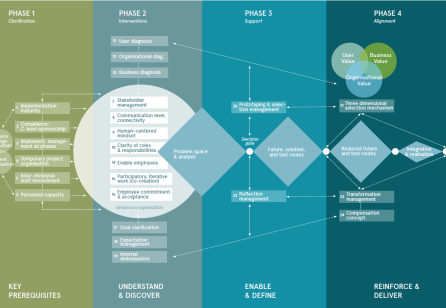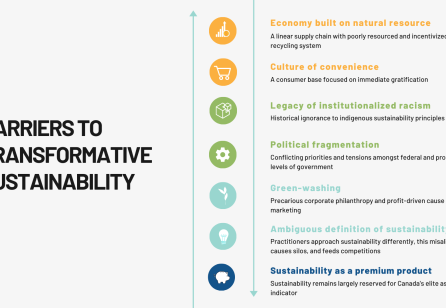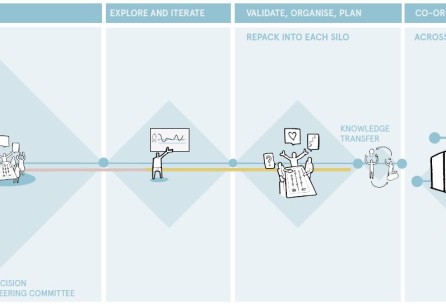What Now? moments can be expected or unexpected. Large scale like Covid-19 or smaller scale but existentially challenging like losing our biggest client. In any case, these sorts of disruptions are destabilising, disorienting and often lead us into unfamiliar terrain. As we move closer to a post-Covid era, public and private sector leaders across the globe are left with questions about where we’ve been and where we go from here. In what is effectively a global What Now? moment, organisations across industries are reconsidering how we work, where we work and how we serve one another in good times and bad. We are all eager to find a sense of stability in the wake of this massive disruption. This uncertain threshold between What Now? and What’s Next, which anthropologists and others refer to as liminal space, is ripe with new possibilities and unique challenges that defy best practices and existing solutions. These extended periods of uncertainty require more than a pivot. Instead, we need to recognise that What Now? moments invite us to stop, ask new questions and explore new ways of understanding what is possible. This begs an interesting question for designers: “What capacities and skills do we need to navigate this uncharted territory and what role might service design play in helping organisations to find their way?”
Living in the liminal
I became fascinated with understanding how we experience liminal spaces about a decade ago when the millennial generation was being characterised in the U.S. and elsewhere as “failing to launch”. Stories about a cohort of entitled, lazy, over-parented young people were everywhere, but at odds with what I observed in my students and young graduates. I saw the ‘stuckness’ that these articles and white papers described, but not as a matter of flawed character among millennials. I suspected there was something else at play and began engaging with cohorts of young people who were stuck in the transition from college to career. It became increasingly clear as I worked with these bright, ambitious and hard-working young people that this was about more than entitlement – or even a challenging economy. Instead, it was that the nature of the choices at the point of transition from youth to early adulthood was different than in years past. These young people faced new challenges and had more options that could be explored over longer time horizons. They were entering an uncertain future armed with best past practices designed for traditional structures that were being dismantled and reimagined. The context of the transition had changed and the prescriptive cultural practices for moving from one life stage to the other no longer served. As I expanded my inquiry to people at different life stages in different circumstances, it became clear that these young people were not alone. People across age, industry and levels of work experience – including among service design professionals – described themselves as feeling “lost” or “disoriented”. Organisational changes and new technologies created paths for non-traditional work and living situations. People at all ages and stages were considering new and varied life paths, with few if any best practices to guide the way. For some, this freedom to explore new terrain was thrilling. For many others, it was paralysing. This excitement/paralysis binary was not only evident in personal experiences and decision making. I also observed it in approaches to the workplace. The emerging and established leaders I worked with were unsure about where they should work, how long they should work there and what work meant in a marketplace where they might work for a dozen companies across multiple industries across their careers. In case after case, regardless of context, a through-line emerged. This led me to open the aperture of my inquiry into a broader question: How do we find our way when the way forward is unclear, and what resources do we need to explore uncharted territory regardless of life stage or context?
Learning to navigate uncharted territory
Whether or not we are conscious of it, we spend most of our time operating in the gap between what we think will happen and a far less predictable reality. Whether we swerve our bicycle to avoid a car door opening, adjust our schedule for a sick child or take a presentation in a new direction when a client asks a surprising question, human beings are much better than we sometimes give ourselves credit for at adapting to new situations and circumstances. We do it every day. Yet, when we perceive these interruptions and disruptions to be threatening – including when we feel lost – our threat response kicks in. We see this play out every day with clients, co-workers and even our families. Fear or frustration may rise in the face of uncertainty, as can excitement and elation. In either case, the destabilisation and disorientation that often follows (even when the disruption or interruption is good news) can lead to reactive decisions and missed opportunities. Of course, we are much better at observing this behaviour in others than we are in ourselves. We see clearly when a client or co-worker chooses to avoid or protect or stride forward without all the information, but sometimes miss or justify when we do the same thing. That is why accepting that What Now? moments are an inevitable part of day-to-day life and acknowledging that having the humility to accept that we are not immune to an inappropriate response and engaging in dispassionate curiosity in the face of uncertainty are key practices we need to develop to better prepare our teams and organisations to navigate uncharted territory. Otherwise, like that person who we perceive to overreact when their plans blow up, we may fall into the trap of mislabelling our own threat reaction as a reasoned response. Once we’ve settled ourselves and accept that we find ourselves in uncharted territory, it is helpful to remember that each What Now? moment we face is unique, and that new contexts require resourcing ourselves to meet the particulars of a new context. Think of it like a wilderness expert who finds themselves off-trail. No matter how much training and expertise they bring to the situation, they still need to get their bearings and read the lay of the land to have the best chance of adapting well to the unknown. This is not new, of course. Forward-thinking organisations have worked tirelessly for decades to trade rigid hierarchical structures for nimble configurations that can more easily adapt to emerging circumstances. We’ve embraced Lean, Agile and other methodologies to move quickly, break down silos and deliver products, services and experiences that customers want. In theory, many organisations are as prepared as they can be structurally to navigate uncharted territory. Unfortunately, organisational leaders and even service designers often take for granted that these structures and frameworks are populated by people whose tolerance for uncertainty and ‘sense of direction’ can be compromised in times when we face What Now? moments. And, in the same way that we don’t pivot and fail forward when we’re lost in the woods, times of prolonged uncertainty where outcomes are unclear may require us to open time and space for sensemaking and discernment. This is why I believe that service design has a unique and critical role to play in helping organisations to find their way in uncharted territory.
Service designers as organisational wayfinders
Service designers are uniquely positioned to provide the tools, techniques and frameworks to help guide organisational leaders and their teams to navigate uncharted territory and see new ways forward when the way is not clear. As we move toward a post- Covid reality, organisations are grappling with new expectations and needs among their employees, customers and other stakeholders. Now more than ever, the tools of service design – such as humancentred research, mapping, sensemaking and making the invisible visible – can play a critical role in helping organisations to find their way forward. But this is about more than tools and techniques. In general, designers thrive in uncertainty. We crave the challenge of finding connections and exploring the spaces where others fear to tread to find new solutions to persistent problems. At least in theory. My engagement with design professionals has uncovered an interesting paradox that is worth noting here. Like the cobbler who has no shoes, designers can also react to What Now? moments as a threat. It turns out that having the training and the toolbox we need to respond in a more measured fashion to uncertain transitions doesn’t always translate to using them to guide our own attempts to adjust to uncertain transitions. Time and again I remind designers that the very tools that make them effective with their clients on behalf of those they hope to serve can be used to map uncharted territories on behalf of themselves and their response to the unknown. If we become more adept at responding to What Now? moments in a measured way – like an emergency room doctor or emergency services professional – I believe service designers have a critical and important role to play as organisational wayfinders. In fact, I believe designers have the tools and resources we need to bust the myth that all change is hard, ambiguity is uncomfortable, and transitions are meant to be painful. Instead, times like these are an invitation for service design to take a leadership role by providing the tools leaders need to step into the uncertainty and understand the challenges they face in ways that are helpful, supportive and oriented toward hopeful solutions. By positioning ourselves as a resource that can be tapped when What Now? moments come and the way forward is unclear, service design has the potential to become a critical resource that leaders call upon to help people to get their bearings and learn to navigate uncharted territory. If we choose to take up this mantle, design has the potential to be a resource across the enterprise, especially in areas like human resources, risk management and strategic planning. I’ll conclude with more questions than answers. We know that the world is an uncertain place. The future of work, life and the planet are beyond our imagination. Uncharted territory can be disorienting, especially if we or those we seek to serve lack the skills, resources and frameworks we need to reorient ourselves when we face change in uncertain times. Rather than rush to find solutions, can we prepare ourselves and our teams to better navigate uncertain transitions by considering some fundamental, but often overlooked questions: How do people orient themselves when they feel lost? Around what do we orient when there is no true north, guiding path or best practices to light the way? How can we bring our experience and expertise into new challenges without falling into the trap of applying old solutions to new problems? As designers we need to go even deeper. Do we conform to the short-term challenges of those we serve or work to inspire a longer, more exploratory view of a changing landscape? Are we properly equipped to respond to living in the liminal? Are conventional tools and techniques enough as we face entirely new challenges? Are there ethical and cultural aspects of learning to navigate liminal spaces that we need to consider as we engage these questions in practice? Asking and answering these questions involves accepting that What Now? moments are destabilising and disorientating for even the most experienced among us. They require leaders and their teams (and us as designers) to intentionally step outside our field of knowing and into that which we don’t know, and to adapt in real time to the unfamiliar. That’s why so many off-the-shelf approaches and established plans lead to quick and overly simplistic fixes in times of uncertainty and change. It is also why learning to operate in uncertain spaces is a key capacity we need to develop as human beings in the 21st century. I believe that service design can and should be at the forefront of these efforts in organisations – and I hope we can work together to find a way to make it so.








Share your thoughts
0 RepliesPlease login to comment